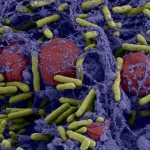Lien vers Pubmed [PMID] – 17197449
J. Biol. Chem. 2007 Feb;282(8):5111-5
Ligand binding to G protein-coupled receptors (GPCRs) is thought to induce changes in receptor conformation that translate into activation of downstream effectors. The link between receptor conformation and activity is still insufficiently understood, as current models of GPCR activation fail to take an increasing amount of experimental data into account. To elucidate structure-function relationships in GPCR activation, we used bioluminescence resonance energy transfer to directly assess the conformation of mutants of the chemokine receptor CXCR4. We analyzed substitutions in the arginine cage DRY motif and in the conserved asparagine N(3.35)119, which are pivotal molecular switches for receptor conformation and activation. G(alpha)(i) activation of the mutants was either similar to wild-type CXCR4 (D133N, Y135A, and N119D) or resulted in loss of activity (R134A and N119K). Mutant N119S was constitutively active but further activated by agonist. Bioluminescence resonance energy transfer analysis suggested no simple correlation between conformational changes in response to ligand binding and activation of G(alpha)(i) by the mutants. Different conformations of active receptors were detected (for wild-type CXCR4, D133N, and N119S), suggesting that different receptor conformations are able to trigger G(alpha)(i) activity. Several conformations were also found for inactive mutants. These data provide biophysical evidence for different receptor conformations being active with respect to a single readout. They support models of GPCR structure-activity relationships that take this conformational flexibility of active receptors into account.

